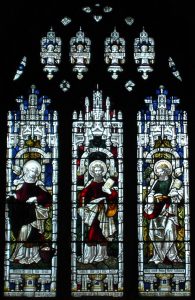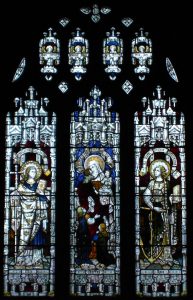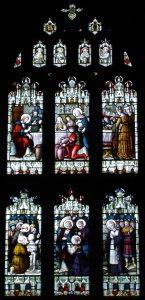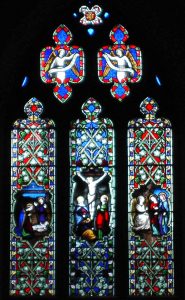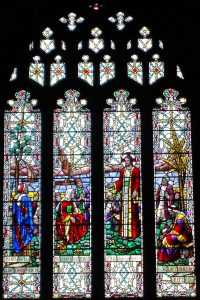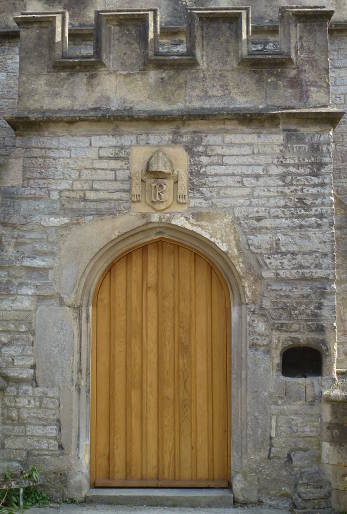
The church was originally a chapel dedicated to St. Benignus or St. Bennings and retained this until the middle of the 17th century. Bishop Benignus was a great friend and disciple of St. Patrick and became his successor.
In 1091 the monks of Glastonbury took the relics of a holy man named Beon or Beonna from Meare to be added to the collection at Glastonbury Abbey; at his last resting place an oration was delivered and, after a liberal offering, a church was built on the site, being consecrated around 1100. Unfortunately the monks confused Beon the hermit of Meare with Benignus the successor of St. Patrick, and the dedication was to St. Benignus rather than St. Beon.
Around 1500 the Norman chapel was completely rebuilt in the perpendicular style with a clerestoried nave and embattled west tower by Abbot Richard Bere (1493-1524), a learned and cultured friend of Erasmus. Bere’s monogram can be seen over the north porch, which also contains a little window used by lepers to receive the holy sacrament, and on one of the unique roof corbels (see below).
After the Dissolution, the Abbot’s country mansion and estate in the hamlet of Sharpham (near Street) passed into the hands of the Dyer family; Sir Edward Dyer, the Elizabethan poet, was born there. Therefore Sharpham became the ‘big house’ of the parish, and the side chapel of the church, which is now occupied by the organ (installed in 1873 and rebuilt in 1927), became The Sharpham Chapel. This was then no longer used for liturgical purposes but for family burials, and was fitted out with a family pew.
The next notable family to live at Sharpham was the Goulds. Under the tower by the west door there is a fine monumental slab to Sir Henry Gould, which was originally on the floor of the Sharpham Chapel. He was Chief Justice of the Queen’s Bench in the reign of Queen Anne. Judge Gould was the grandfather of the novelist Henry Fielding who was born at Sharpham Park in 1707. The register from this time is unfortunately missing but there is little doubt that he was baptised in St Benedict’s as there is a record of his sister being baptised here in the following year.
By the time Phelps, the Somerset historian, had visited in 1836 and noted that repair work had been carried out, the church had become generally known as St Benedict’s through usage and convenience. Then in 1862, under the architect Benjamin Ferrey, who also designed the town’s market cross, more substantial restoration work was carried out. This included the removal of the oak box pews and the gallery, and the reseating of the church in pitch-pine, together with the refurbishment of the chancel. The latter was given new altar rails, choir stalls, and lectern. Around the same time a chapel in the south aisle was built by the Reverend Allnutt, in memory of his two daughters who died aged 3 days and 14 years. It was finished as a Lady Chapel by Prebendary Townsend and was dedicated in 1953.
In the late 1880s, following the launch of an appeal, extensive restoration and enlargement was carried out under the architect, JD Sedding, and local builder Merrick. The south wall was completely taken down and rebuilt with matching arcade, and a new south aisle was added. The north wall was also rebuilt and the rest of the fabric restored. The nave and aisles were re-roofed, new floors were laid, and all vaults were filled in. A heating system was installed and considerable work was done on the tower, including new pinnacles.
The origin of the crucifix on the wall above the chancel arch is unknown.
The Windows
Until the time of Queen Victoria very few people could write, so Bible stories were made into stained glass windows which everyone could understand. The original windows in St. Benedict’s were replaced by the present ones around 1840 when the church was re-ordered.
In the descriptions that follow, if you click on any of the window pictures you’ll get a full screen version of the picture at higher resolution in a new tab.
The two windows on the main part of the south aisle were donated by members of the Holman family. Starting from the right the first window contains three panels:
1. Joseph of Arimathea holding a staff from which the Holy Thorn is growing. Slips of this tree – which can still be seen in bloom at Christmas – have grown into mature trees in the Abbey, outside St. John’s Church, and on Wearyall Hill. Also, a cutting is growing in the churchyard at the west end of the church.
2. St Paul
3. Dorcas, who was raised from the dead by Peter. (Acts 9:36 – 43).
Note her sewing in one hand and her other arm shaped as though to carry children; also the basket of loaves in the bottom right hand corner.
The Lady Chapel contains four lovely windows. They show the four Gospel writers and their trades or professions:
1. Matthew the tax collector. The angel with a scroll reminds us of the opening genealogy to the gospel which the Angel has inscribed on the scroll.
2. Mark, who was the first to write a Gospel. He came from the family of Ezekiel. The lion in the corner symbolises Ezekiel’s vision of “a lion at his feet”.
3. Luke, who was not a disciple and to our knowledge never saw Jesus. He was however commissioned to research the life of Christ. Luke’s gospel begins with Zechariah the priest who would have made sacrifices according to the law which included an ox seen beside him.
4. John, who has a young face with no beard. Beside is the eagle to symbolise the carrying of the gospel to all, reminding us of his Gospel’s opening words: “In the beginning was the word”.
